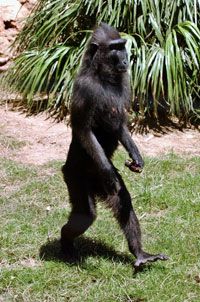For years, scientists and armchair philosophers have pondered one of humanity's great evolutionary concerns: Why do humans walk on two legs? We have four limbs, and our ape friends seem to get along well on all fours (by doing what's called knucklewalking), so what makes walking on two legs better? Or, if it's not better, why do we do it at all?
Monkey Image Gallery
Advertisement
Scientists know that bipedalism was one of the first features to develop in early hominids -- early human ancestors that had already diverged from apes. And a variety of theories attempt to explain why, yet some of the theories seem to contradict one another. A study published in the July 2007 issue of Proceedings of the National Academy of Sciences attempts to provide a definitive answer. It claims that human bipedalism boils down to one thing: energy.
The study, performed by three researchers from the University of Arizona, the University of California, Davis, and Washington University in St. Louis, examined differences in upright walking between four adult humans and five adult chimpanzees. Chimpanzees were used because they're the closest modern-day relative to humans. (Four to seven million years ago, humans and chimpanzees diverged from a common ancestor. They then developed independently.)
Researchers taught the five adult chimpanzees to walk on treadmills. They walked upright on their hind legs and knucklewalked on all fours. The chimps wore masks that tracked how much oxygen they used. The researchers also measured how much pressure was exerted on the treadmill. This revealed which muscles the animals were using. The same measurements were taken for the four adult humans.
The walking tests showed that the chimps, as a group, averaged the same energy expenditure walking on all fours as they did walking on two legs. As a group, the humans used 75 percent less energy walking upright than the chimps used walking on all fours. Essentially, walking upright seemed to be beneficial because it saved energy.
But what appeared even more interesting was that the amount of energy expended by the chimps varied between them. One chimp used less energy on two legs than on all fours. Another used the same in both walking positions, and the other three used more energy when walking on two legs. The variations were traced to how the chimps walked and differences in body structures. One of the scientists expressed excitement at this variation, saying that it reflected an essential part of evolution [source: Discovery News].
Analysis of videotapes of the walking chimps showed that chimps generally use large hip muscles and take short steps when walking upright. Humans tend to use smaller muscles, like those in their lower legs, and to take longer steps. This leads to improved energy efficiency. Not coincidentally, the chimps that took longer upright strides than their peers consumed less energy.
The experiment's results illustrate how energy expenditure contributed to human evolution. Early humans who adapted to expend less energy walking upright are represented in the fossil record. Fossils show that some ancient humans developed longer legs, different hip structures or thicker leg bones, consistent with modern-day humans. These adaptations made upright walking easier and lessened the amount of energy required to walk upright.
On the next page, we'll look at other theories about why humans walk upright and at more links between humans and primates.
Advertisement



